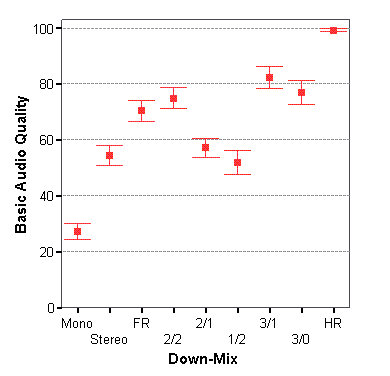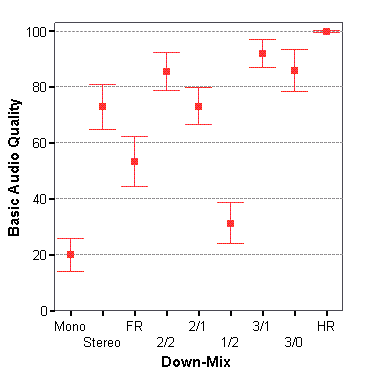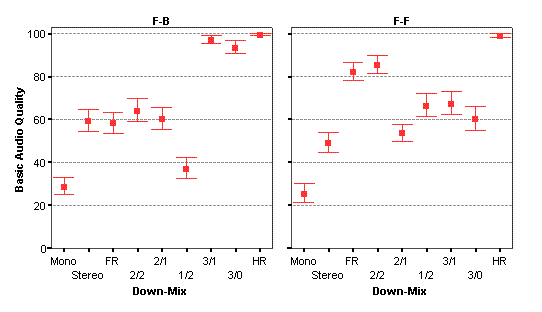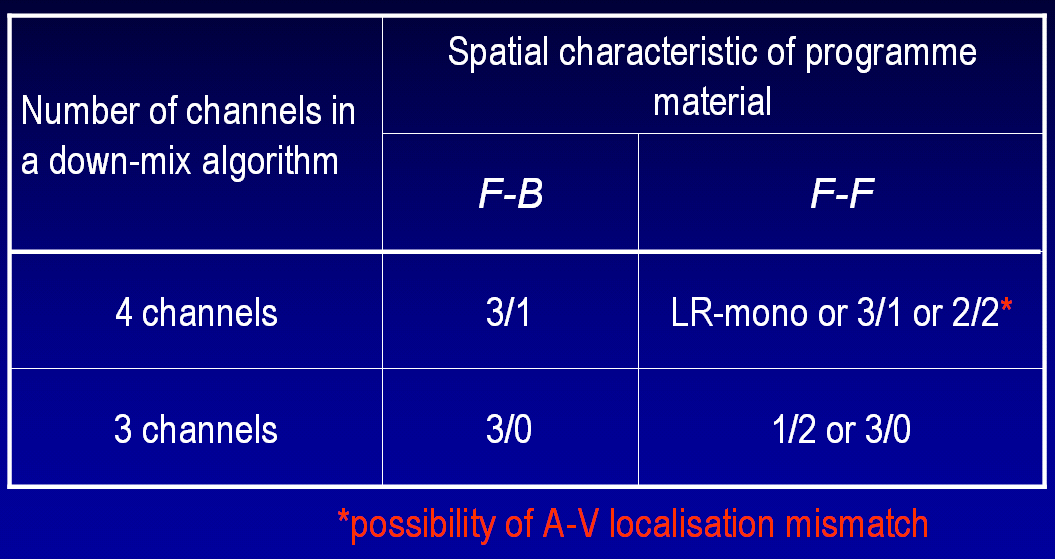Reports on Progress:
Comparison of Down-Mix Algorithms
In this experiment a number of down-mix algorithms for a standard 5.1 multichannel audio set-up were evaluated in terms of basic audio quality. The investigation was limited to two listening positions. Fig. 1 shows the results of evaluation of selected down-mix algorithms at the centre listening position (averaged across all programme material). For detailed description of the experimental procedure and down-mix algorithms see (Zielinski 2003d). Fig. 2 presents the results obtained for a classical music recording at the centre listening position. Fig.1 Audio quality of selected down-mix algorithms at centre listening position (mean values and 95% confidence intervals). Scores averaged for all programme material.
Fig.1 Audio quality of selected down-mix algorithms at centre listening position (mean values and 95% confidence intervals). Scores averaged for all programme material.
 Fig.2 Audio quality of selected down-mix algorithms at centre listening position - scores obtained for Classical Music.
Fig.2 Audio quality of selected down-mix algorithms at centre listening position - scores obtained for Classical Music.
It was found out that the results depend mainly on the spatial scene characteristics of programme material. Fig. 3 below shows the results obtained for two most typical spatial audio scenes (F-B on the left and F-F on the right). Click here for more information about spatial audio scenes.
 Fig.3 Audio quality of selected down-mix algorithms at centre listening position split for two most typical audio scenes.
Fig.3 Audio quality of selected down-mix algorithms at centre listening position split for two most typical audio scenes.
The most important results obtained in the experiment are summarised in table below:
 Limitation of the number of channels from 5 to 4 for programme material having foreground content in the front and a background content in the rear (F-B spatial characteristic) may be accomplished "gracefully" by means of the 3/1 down-mix algorithm. Further limitation down to 3 channels can be performed with minimum loss of quality using the 3/0 down-mix algorithm.
The results obtained for programme material with foreground content in all channels (F-F spatial characteristic) are not very conclusive in the case of 4-channel down-mix algorithms. It was found that all the evaluated 4-channel algorithms ('LR-mono', 3/1 and 2/2) may give subjectively good results depending on programme material. Limitation of channels from 5 to 3 for programme material having the F-F spatial characteristic may be achieved with best subjective results by means of the 1/2 or the 3/0 down-mix algorithm.
The degradation of audio quality due to the change of the listening position from the centre to the off-centre one was also investigated. The most pronounced degradation of quality (20 points on the 100-point scale) was observed for the original recordings and for items processed using the 2/2 down-mix algorithm (a so called "phantom centre" algorithm). Degradation of quality for the items processed using the remaining down-mix algorithms was much smaller, which shows that the standard 5.1 set-up may provide stable audio quality across a relatively large listening area for some down-mix algorithms.
The obtained results prove the importance of the centre channel, especially in the context of the audio-visual presentation. It was found that presentation of the picture had a negative influence on evaluation of audio quality at the off-centre listening position for down-mix algorithms not employing the centre channel (2/2, 2/1, 2/0). Informal feedback from the listeners supports the hypothesis that this effect was caused by audio-visual localisation mismatch.
Limitation of the number of channels from 5 to 4 for programme material having foreground content in the front and a background content in the rear (F-B spatial characteristic) may be accomplished "gracefully" by means of the 3/1 down-mix algorithm. Further limitation down to 3 channels can be performed with minimum loss of quality using the 3/0 down-mix algorithm.
The results obtained for programme material with foreground content in all channels (F-F spatial characteristic) are not very conclusive in the case of 4-channel down-mix algorithms. It was found that all the evaluated 4-channel algorithms ('LR-mono', 3/1 and 2/2) may give subjectively good results depending on programme material. Limitation of channels from 5 to 3 for programme material having the F-F spatial characteristic may be achieved with best subjective results by means of the 1/2 or the 3/0 down-mix algorithm.
The degradation of audio quality due to the change of the listening position from the centre to the off-centre one was also investigated. The most pronounced degradation of quality (20 points on the 100-point scale) was observed for the original recordings and for items processed using the 2/2 down-mix algorithm (a so called "phantom centre" algorithm). Degradation of quality for the items processed using the remaining down-mix algorithms was much smaller, which shows that the standard 5.1 set-up may provide stable audio quality across a relatively large listening area for some down-mix algorithms.
The obtained results prove the importance of the centre channel, especially in the context of the audio-visual presentation. It was found that presentation of the picture had a negative influence on evaluation of audio quality at the off-centre listening position for down-mix algorithms not employing the centre channel (2/2, 2/1, 2/0). Informal feedback from the listeners supports the hypothesis that this effect was caused by audio-visual localisation mismatch.
